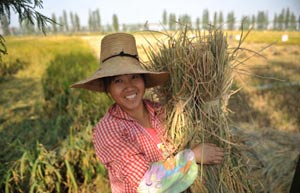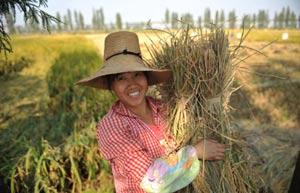

 The per capita net income of farmers and herdsmen in Tibet hit 6,578 yuan ($1,071) in 2013, marking double-digit growth for 11 consecutive years.
The per capita net income of farmers and herdsmen in Tibet hit 6,578 yuan ($1,071) in 2013, marking double-digit growth for 11 consecutive years.
 "I expect favorable measures in fund-raising and government support in planting techniques during the upcoming two sessions," Lei said.
"I expect favorable measures in fund-raising and government support in planting techniques during the upcoming two sessions," Lei said.
 The use rights of 340 million mu (22.7 million hectares) of farmland had been transferred to larger farming entities as of the end of 2013.
The use rights of 340 million mu (22.7 million hectares) of farmland had been transferred to larger farming entities as of the end of 2013.
The Chinese central government has invested 61.8 billion yuan ($10.1 billion) improving schoolhouses and educational facilities in rural areas over the past four years.
According to the Chongqing Agricultural Commission, 3.8 billion yuan in capital was invested in a total of 11,000 farming projects in Chongqing from 2008 to 2012.
Liu Zhengming's newly built farmhouse is equipped with all the electrical appliances and mod-cons you would find in a city household.
 China has long been a large agricultural nation, therefore the work concerning agriculture, countryside and farmers have always been the top priority.
China has long been a large agricultural nation, therefore the work concerning agriculture, countryside and farmers have always been the top priority.
China feeds 22% of the global population using only 7% of the world's farmland, and it is now ready to push forward a new round of agricultural reforms.
China's recent move to encourage farmers to transfer the using rights of their contracted land will enhance social equity and production efficiency.
China's arable land amounted 135.4 million hectares at the end of 2012, according to the result of the second national land survey released on Monday.
But the fact is, for a long time, being a "farmer" has been an undesirable identity in China, due to farmers' low incomes and poor living conditions.
New pricing modifications for expropriated land in Hebei province will be released in 2014, raising the average compensation standards to guarantee farmers receive more money.